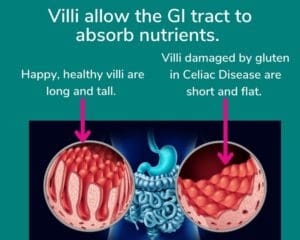Celiac disease is a condition that affects millions of people all over the world. Still, it often is misunderstood. Celiac Disease is not a “wheat allergy” or a “gluten sensitivity.” Celiac Disease is an inappropriate immune response to gluten. If left untreated, it can have serious consequences. In this article, we will break discuss:
- What Celiac Disease really is,
- How it differs from wheat allergy and gluten sensitivity, and
- What to do if you suspect your child has it.
What is Celiac Disease?
Celiac Disease is an immune condition triggered by gluten. This disease occurs in genetically-susceptible individuals. Gluten is a protein found in some grains. Examples of gluten-containing grains include:
- Wheat
- Rye
- Barley
- Triticale
When someone with Celiac Disease eats a gluten-containing food, the immune system responds. This response damages the lining of the small intestine. The exact mechanism through which this occurs is complex. It involves cells that line the GI tract and immune cells that interact with the GI tract. The response involves the following steps:
- Gluten is taken up into certain cells of the GI tract.
- Immune cells recognize the gluten within those cells as dangerous so wage an attack.
- The GI tract cells are damaged by the immune cells' attacks toward gluten.

From this description, you can tell that this immune response is very different from the immune responses we've discussed in food allergy articles. The main difference is that IgE is really not at all involved. In fact, completely different immunoglobulins are present in people with Celiac Disease. You can read more about those.
Symptoms of Celiac Disease commonly include:
- Abdominal pain
- Bloating
- Diarrhea
- Fatigue
- Other symptoms are detailed nicely on Celiac.org
Treatment for Celiac Disease includes strict gluten avoidance. It's important to follow closely with a gastroenterologist if you or your child has Celiac Disease. If you suspect Celiac Disease, talk with your physician.
What is Wheat Allergy?
In contrast to Celiac Disease, wheat allergy is a food allergy most mediated by IgE. We talk a lot about IgE-mediated food allergies in this earlier post. Wheat also plays a role in non-IgE-mediated food allergies and in mixed IgE-and-non-IgE-mediated food allergies. Wheat can be involved in:
- IgE-mediated food allergy
- Food-dependent exercise-induced anaphylaxis
- Food Protein Induced Enterocolitis Syndrome (FPIES)
- Eosinophilic Esophagitis (EOE)
- Food-Induced Flaring of Atopic Dermatitis
Gluten is not the same thing as wheat. Wheat is a grain, and it contains the protein gluten. Wheat protein is the allergen in wheat allergy. Because wheat protein is structurally different from gluten protein, the two are not interchangeable. This is why many patients with wheat allergy can actually eat barley and rye, amongst other grains, without having an allergic reaction. It's because barley and rye proteins are structurally different from wheat protein.
It's important to differentiate between wheat allergy and Celiac Disease. That's because the treatments for these disorders are different. For wheat allergy, wheat avoidance is the most common treatment. If IgE-mediated wheat allergy is present, oral immunotherapy can be considered. Accidental ingestions with wheat allergy can cause life-threatening anaphylaxis, and the treatment for anaphylaxis is epinephrine.
What is Non-Celiac Gluten Sensitivity?
Non-celiac gluten sensitivity (NCGS) is a real condition, but it is different from Celiac Disease. NCGS does not involve the immune system in the same way that Celiac Disease does. Patients with NCGS may have symptoms that are similar to patients with Celiac Disease, such as:
- Abdominal pain
- Bloating
- Diarrhea
- Fatigue
The immune response in NCGS is different than that in Celiac Disease and in wheat allergy. For a deep dive on that response, check out this article from the academic journal Gastroenterology. Here's an overview of it.
NCGS is treated with gluten avoidance, and it is important to follow with a physician who's familiar with this condition.
What To Do If You Suspect Celiac Disease or Another Gluten-Associated Problem
It's critical to see a physician who is familiar with these disorders and for you to be heard. Science has come a long way in helping us understand how our bodies interact with foods. That said, there is still so much we don't know. Talk with your or your kiddo's allergist or gastroenterologist about your concerns. And, of course, don't stop advocating for your family. You've got this!

Thanks for reading this post “Celiac Disease: What It Is and Isn't and What To Do About It.” Do you have any questions about food allergies? Reach out to me! And be sure to check out my other blog posts and podcast episodes about all things food allergy. Thanks for reading!
– Dr. Hoyt
P.S. Food allergy testing can be super confusing, so I've created this awesome ebook to clarify the facts from the fiction! Get your copy today!
Are you in need of an allergist in your area? Check out these allergist finder tools:
AAAAI Allergist Finder: https://allergist.aaaai.org/find/
ACAAI Allergist Finder: https://acaai.org/locate-an-allergist
Do you have food allergy questions? Have them answered by Dr. Alice Hoyt, Pam, and guests on the podcast!
Submit your questions HERE!
A note from Dr. Hoyt
I have talked about a non-profit…
Pam and I volunteer with the non-profit The Teal Schoolhouse. Its primary program is Code Ana. Code Ana equips schools for medical emergencies like anaphylaxis.
Code Ana’s Online Epinephrine Training Program helps support that goal. Through this program, you will educate yourself while you support this important mission!
A medical emergency response plan is important for everyone at any school. Code Ana's program Med-E Ready is a comprehensive approach to school-focused medical preparedness. This program guides schools through the process of creating a medical emergency response plan. A response team is also developed! This is one of the most important components of a school's food allergy policy!
Does your kiddo’s school have Code Ana?
You've just read Dr. Hoyt's post “Celiac Disease: What It Is and Isn't and What To Do About It.” Remember, she's an allergist, but she isn't your allergist, so talk with your allergist about what you've just learned!



